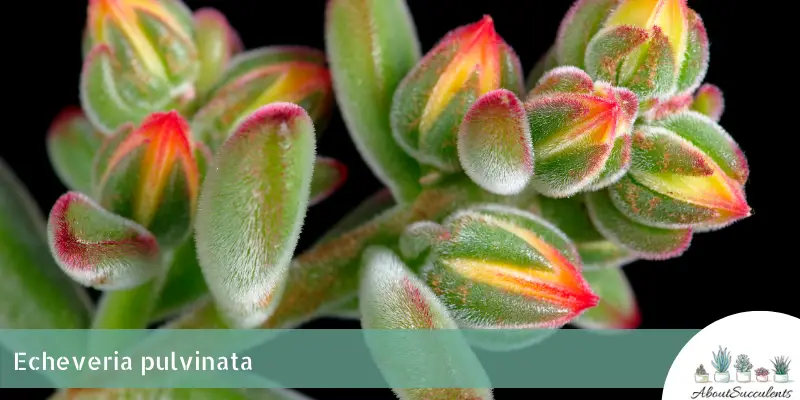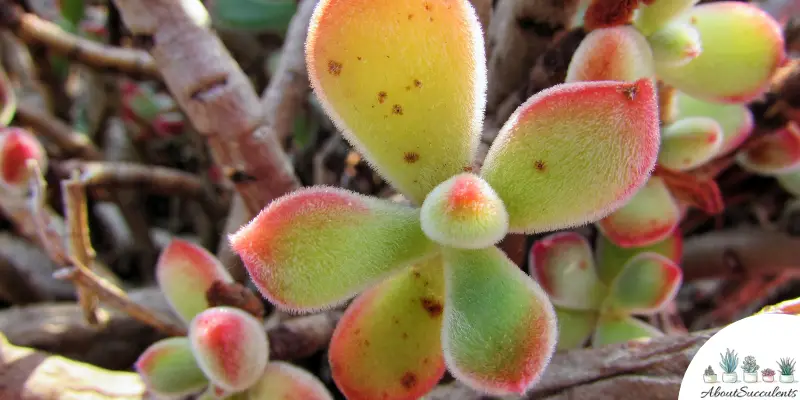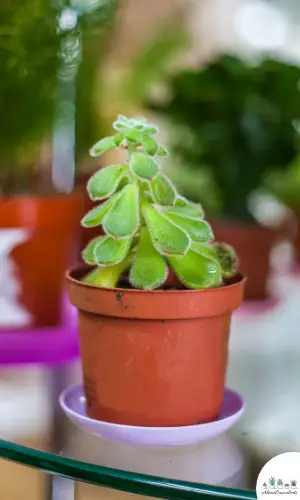
Echeveria pulvinata is a strikingly beautiful succulent that’s well-loved for its bright green leaves with margins accented in colors ranging from pink to red. Onlookers are amused at the white, fuzzy hairs that cover the leaves. But these textures have a purpose. They are designed by nature to protect the plant from losing water.
Also known as Chenille Plant or Plush Plant, if you see more hummingbirds hovering in your garden during springtime, that means the succulent has given you charming orange, bell-shaped flowers.
Chenille Plant can grow to a height of 12-inches (30.5cm) and 4-inches (10cm) wide. It comes from the Echeveria genus and belongs to the Crassulaceae family. Echeveria pulvinata is native to Central Mexico.
General Information
Also known as: Chenille Plant, Plush Plant
Plant Family: Crassulaceae
Origin: Central Mexico
Height: 12-inches (30.5cm)
Exposure: Partial to full sunlight for up to 6 hours per day
Water Needs: Drought-tolerant; follow the “Soak and Dry” method where you give the soil drenching or soaking only when you’ve confirmed that it has 100% dried out.
Soil Type: Succulent soil mix; 2:1 ratio of potting soil to coarse sand or 1:1:1 ratio of potting soil to coarse sand to perlite.
Soil pH: 5.6 to 7.8
How to Grow and Care for Echeveria Pulvinata

With Echeveris pulvinata, you have the perfect match – someone extraordinarily lovely, yet easy to grow and care for.
This succulent is a low-maintenance head-turner. You can ignore Chenille Plant and you’ll get more love. Basically, you just plant Echeveria and fuss over it once in a few days.
Keep in mind that Chenille Plant isn’t cold-hardy. If you live in a region whereby the mercury can drop below 20° F (-6.7° C), it would be best to plant Echeveria pulvinata in a pot that can be moved indoors.
Sunlight
Echeveria pulvinata thrives in partial to full sunlight conditions. What you need to avoid is exposing Chenille Plant to the afternoon sun where the intense rays can burn its leaves.
If you decide to keep Echeveria pulvinata in your garden, plant it in a location that gets up to 6 hours per day of partial to full sun. As an indoor plant, place the pot near a window that receives 4 to 6 hours of partial sunlight per day. If this isn’t a consistent option, place Chenille Plant under a Grow Light.
It’s important to make sure that Echeveria gets its daily dose of the sun’s rays. If not, it will develop a condition called etiolation where the leaves stretch out and wither away.
Watering

Watering is the one area where a lot of succulent growers get wrong. And it’s understandable because Echeveria pulvinata is a plant. However, as a succulent, it already stores plenty of water in its leaves and stems to enable it to survive drought conditions.
Giving it more water than it needs will be disastrous for the health of Echeveria pulvinata. The soil will remain moist for a long time and become a breeding ground for bacteria and fungi.
Chenille Plant’s roots will start to rot and the fungi will creep their way inside your succulent – spreading infection.
To keep Echeveria pulvinata healthy, water it sparingly. Use the “Soak and Dry” method whereby you only water the soil when you have confirmed that it has completely dried out.
You can test the dryness of the soil by simply inserting your finger or a stick an inch deep. If the stick feels dry, drench the soil with water.
Pot and Soil
Choosing the ideal pot for Echeveria pulvinata is easy. The primary consideration is for the pot to support proper soil drainage. If Chenille Plant was housed in a glass or plastic container, ditch it and buy a pot that’s made of unglazed ceramic or terracotta.
Both unglazed ceramic and terracotta allow moisture to escape from the soil protecting the roots from rotting. You should also choose a pot that’s slightly larger than the base of the plant to give the roots space to grow.
Lastly, check that the bottom of the pot has a drain hole to let the excess water run out.
The ideal soil for Echeveria pulvinata is any commercial succulent mix. You can also make yours by mixing potting soil with coarse sand at a 2:1 ratio. Another option is a 1:1:1 mix of potting soil, perlite, and coarse sand.
You can fertilize the soil once a month during the growing season or summer. Fertilizer improves the level of nutrition in the soil. Make sure that the fertilizer is diluted to only 25% of its original strength.
How to Propagate Echeveria Pulvinata
Why buy more when you can just propagate Echeveria pulvinata? Propagating Chenille Plant is an activity you can do by yourself or with your kids. It’s fun and easy to do.
There are 2 methods to choose from: Stem Cuttings or Leaves.
Stem Cuttings Method
Step 1: Choose a healthy stem and cut a small section with a sterilized and sharpened knife.
Step 2: Allow the stem cuttings to dry out and form hard calluses. This process will take 2 to 4 days.
Step 3: Once the calluses have formed, place the cuttings on well-draining soil.
Step 4: Lightly water the soil and place the container near a window that gets partial sun.
Step 5: Examine the cuttings. If the cuttings have developed roots, water the soil only when it has dried out completely.
Leaves Method
Step 1: Find a healthy leaf and perform a smooth twist and pull. Make sure that no part of the leaf remains on the stem to ensure successful propagation.
Step 2: Give the leaves 2 to 4 days to develop calluses.
Step 3: When the leaves have callused over, plant them on well-draining soil.
Step 4: Lightly water the soil and position the pot near a window where it can receive partial sunlight every day.
Step 5: Once the roots have formed, limit the watering to only whenever the soil has dried out.
Frequently Asked Questions
Is Echeveria Pulvinata Toxic To Cats and Dogs?
Echeveria pulvinata isn’t included in the list of plants toxic to cats and dogs that appear on the website of the American Society for the Prevention of Cruelty to Animals (ASPCA).
Why Is My Echeveria Pulvinata Dying?
Echeveria pulivinata is a durable plant and resistant to harsh conditions but it can succumb to overwatering and pest infestation. If you act quickly, you can still save Chenille Plant.
Overwatering
Earlier we discussed that giving the soil more water than it needs will do Echeveria pulvinata more harm than good.
A telltale sign that infection has taken place is discoloration on the leaves. If you see yellowish-blackish spots or notice that the leaves have grown mushy, don’t take chances and assume your succulent is contaminated.
Remove all of the infected sections with a sterilized and sharpened knife. After every use, sterilize the knife to keep it from spreading the bacteria.
Once all of the infected sections have been removed, do the same to Chenille Plant’s roots. Then, allow it to rest and recover.
In the meantime, prepare a new pot with fresh succulent soil. When Chenille Plant has dried out, replant it in the soil. Don’t water just yet. Give Echeveria pulvinata 2 days to adjust to its new environment.
Pest Infestation
Mealybugs are the #1 fan of Echeveria pulvinata. Unfortunately, these are the types of “fans” that take and give. Mealybugs take sap and give substances that can kill your precious succulent.
Wipe off the waxy, white substances with a cotton ball soaked in 70% isopropyl alcohol. Spray the plant with diluted neem oil to keep the pests away.
Yes, Echeveria Pulvinata produces orange, bell-shaped flowers in the spring.
Last Updated on June 9, 2022 by Sofia Lara